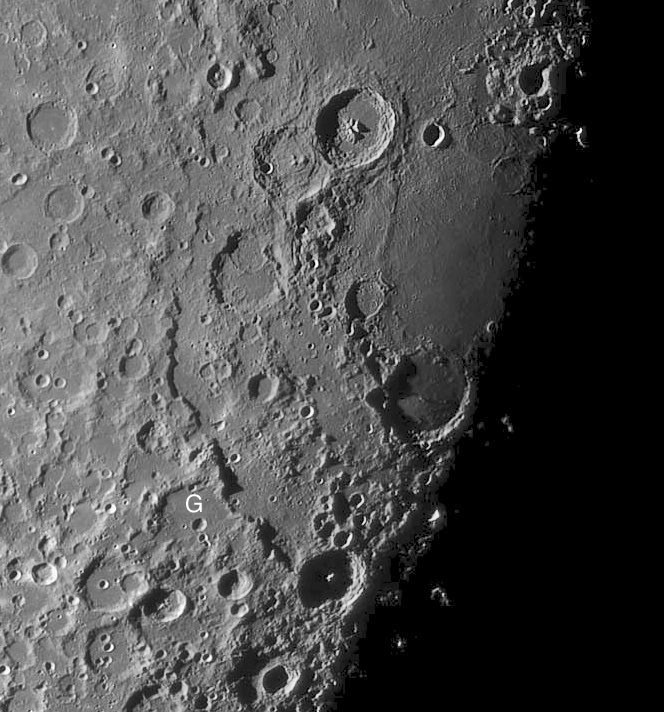LPOD Feb 4, 2008
FOUR RINGS AND A MYSTERY

image by Michael Karrer, St.Radegund, Austria
The most photographed places on the Moon are generally the conspicuous craters, followed by the impact basins. And even though LPOD has featured most of the nearside basins, I often see something new to point out on new images. In this case, Nectaris caught my eye on Michael's mosaic of the waning gibbous Moon. First, there are the three main basin rings, the Altai rim (diameter of 860 km), the Santbeck-Cyrillus ring (620 km) and the Pyrenees-Fracastorius ring (400 km). Additionally, a rather straight part of the innermost mare ridge ring (240 km) is visible. It is interesting the the Santbeck-Cyrillus ring is so wide and not a single line of hills or a scarp; it is, in fact, similar in this way to the Rook ring of Orientale which has Inner and Outer Rook arcs. The diameter of Nectaris is only 70 km less than Orientale so the rings and the ejecta might be expected to be similar, but the crater Rothmann G points out a big difference. The 119 km wide crater is older than the Nectaris basin because its eastern rim is truncated by the Altai basin rim. At Orientale, older craters near the basin rim are completely obliterated by thick deposits of ejecta; why can we still see pre-Nectaris craters right at its rim? I don't know, so its time for speculation. Perhaps the interpretion of G as older than Nectaris is wrong. This is possible because the Altai Scarp may have formed (or have been rejuvenated) sometime after the basin's formation. This was suggested in 1971 by Hartmann and Wood because the scarp is quite fresh looking, whereas Nectaris is an old basin. Here is a possible history. The Nectaris basin forms, surrounding itself with thick piles of ejecta. Later impact craters form in the ejecta. Subsequently the Altai Scarp is elevated, thus looking fresher than the rest of the basin. Look again at the Altai Scarp in Michael's image - notice that its lowest height is exactly where it intersects Rothmann G. Did G form on top of the earlier, lower scarp, cutting into it, and then later the scarp's relief increased by slight raising of the scarp and lowering of the area inside it? Possibly, and I have this image to thank for stimulating the entire question!
Chuck Wood
Technical Details
2007-10-01. 7"/f8 TMB Refractor at prime focus (1400mm) + Lumenera SKYnyx 2-1mcamera + Baader FFC + Baader 685nm IRpass filter; exposure time: 6 ms. 100 images selected by Registax 4 (multipoint aligment); final processing in Photoshop.
On Rükl's plate 57 it is not clear which patrynomic feature the crater labeled G is named for, but on the System of Lunar Craters chart B6 an arrow points clearly to Rothmann.
Related Links
Rükl plate 57
Michael's website
Index of past LPOD's